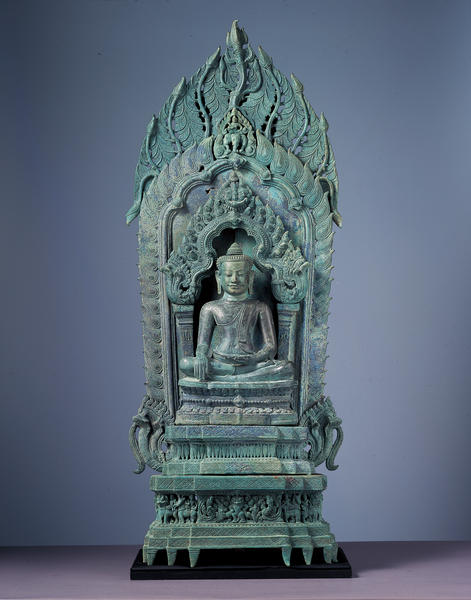仏陀坐像
- カンボジア バイヨン
- 12-13c
- 青銅
仏陀は結跏趺座し左手は与願印、右手は降魔印を示す。衣は僧衣で偏袒右肩に懸ける。頭部の光背は両端に頭部を持つマカラであるが様式化された火炎を背中から立ち上がらせ、ナーガを口から吐いている。その頂部には邪気をはらうカーラの頭部が付く。両端のマカラの頭部を各々角柱で支え、建築的意匠を示す。挙身光にあたる部分も同様の構成が見られるが、その頂部はインドラ神が三頭の像の上に座し守護している。インドラはアンコール時代の龕上部に良く見られる装飾である。挙身光の上には動きのある菩提樹が立ち上がり、この樹の下で降魔成道した仏陀の姿を荘厳に表している。半眼で瞑想する仏陀の表情には、仏教を擁護したジャヤバルマン7世の時代のおだやかで洗練されたほほえみが感じられる。
Catalogue Entry
This image of Sakyamuni Buddha has the legs folded in the full-lotus position, the right hand in the gesture of the “wish-granting mudra” (yogan-in) and the left hand in the “demon-subduing mudra” (goma-in). He wears a priest’s robe with the right shoulder bare. The head halo represents a legendary animal, makara, that, in this case, has a head at both edges. With stylized flames rising from the back, the makara spouts forth naga (cobra) from both sides. Attached to the top is the head of a kara monster that drives away evil. The heads of the makara are each supported by a square pillar, showing an architectural design. The “whole body” halo has a similar composition, but at its top is the god Indra sitting on three elephants keeping guard. Indra often appears in the decorations adorning the top of buddha alcoves during the Angkor period. A dynamic pipal tree rises over the whole body halo, representing the moment when the Buddha overcame demons and achieved enlightenment under the papal tree at Bodh-Gaya. The countenance of the Buddha in meditation with half-closed eyes has the mild, refined smile peculiar to works from the reign of Jayavarman VII, an ardent patron of Buddhism.
